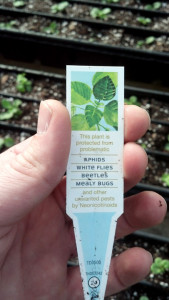
Environmental groups have pressured retailers this past year to label neonicotinoid-treated plants. This Home Depot label also tells why the plant was treated.
Are insecticides to blame for killing off the honey bee? That question has stimulated lively debate in both scientific and policy circles the past two years. At the heart of the controversy is a group of insecticides known as neonicotinoids. Neonics, as they’re sometimes called, have risen over the past 20 years to become the number one class of insecticides sold worldwide, and are being used increasingly by nurseries and home gardeners to control a variety of landscape and garden pest problems.
Environmental groups contend that the case is cut and dry, namely that neonics are the reason for colony collapse disorder (CCD), a bee killing phenomenon that keeps commercial beekeepers awake at night. Yet, most bee researchers agree that the issues surrounding CCD are complex and technical, and that pesticides are certainly not the whole picture. In a newly reported study, conducted by researchers at the University of Maryland, field realistic levels of the popular neonic, imidacloprid, did not appear to have any detectable effect on bees. This despite earlier studies which showed that neonics appear to affect bees in subtle but dangerous ways.
Much of this debate about neonics has centered on what constitutes “field realistic levels” of imidacloprid and its neonic cousins. Industry representatives have contended that some recent critical studies, cited by environmentalists as justifying a ban neonicotinoids, were flawed because they were based on unrealistically high levels of the insecticides.
Maryland researchers tried to address these concerns by feeding their bees imidacloprid in protein supplement patties at doses of 5, 20, and 100 micrograms per kilogram (parts per billion). The lowest dose, 5 parts per billion, has come to be recognized as field realistic based on several studies of pesticide concentrations in the nectar and pollen of treated crops. The insecticide-laced protein supplement was provided to the bees over a continuous 12 week period. Even so this was, the authors contend, a higher exposure scenario than would likely occur in agricultural settings, where the contaminated pollen and nectar is not likely to be present continuously.
The research shows that as dosage of the insecticide in the food increases, colony survivorship decreases; however the field-realistic dose does not significantly affect key bee health indicators, including foraging, and winter survival. The major impact of higher imidacloprid exposures is increased periods when brood (bee larvae) are not produced due to weak and dying queens late in the summer. Such effects can lead to lowered overwintering survival, a character of CCD.
While not letting insecticides off the hook entirely, the authors conclude that although short term exposure to high imidacloprid levels (represented by 100 part per billion dosages in this study) does occur in agricultural settings; it is not likely to occur continuously throughout a crop cycle. Also, data from the study show that bees are efficient in metabolizing imidacloprid, so that short term spikes in insecticide levels in nectar are likely to be quickly diluted and eliminated by the bees. They conclude that while imidacloprid might be a contributing factor to some overwintering losses in bees, seed treated crops with low residue levels are likely to have negligible effects on honey bee colony health.
In the ongoing debate over bee health, I’m pretty sure this study won’t be the final word. And I doubt that the concerns of neonics critics will be wholly satisfied. In time there will be more studies done, and we will get closer to the truth about CCD and neonics.
Meanwhile, gardeners should take care when using neonicotinoid insecticides (or any insecticides) in the garden. Never treat a blooming plant with an insecticide, especially during the day when bees are foraging. By all means use alternatives to neonics when good ones exist. There are some pests (like tough scales or some borers), however, that do not have good alternatives.
Should you be concerned about buying plants in the nursery that have been treated with a neonic? Or about treating a few trees, or beds of non-blooming plants in your yard? Such applications, if done according to label directions, should pose negligible risks to bee colonies. Why? The small amounts of neonicotinoid residues in nursery seedling tissues become even more dilute as the plant grows. Furthermore, bees forage in lots of yards and fields, relatively few of which are typically treated with insecticides in urban areas. As this study suggests, small amounts of insecticide picked up from a few treated plants are likely to be quickly diluted and metabolized within a hive.